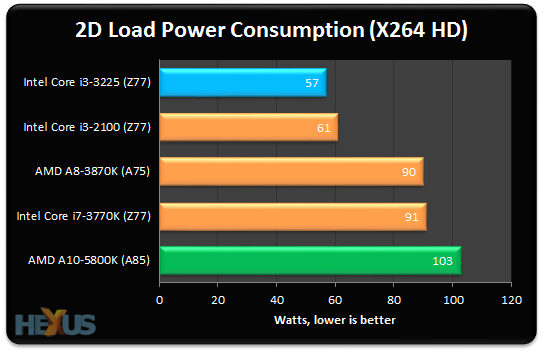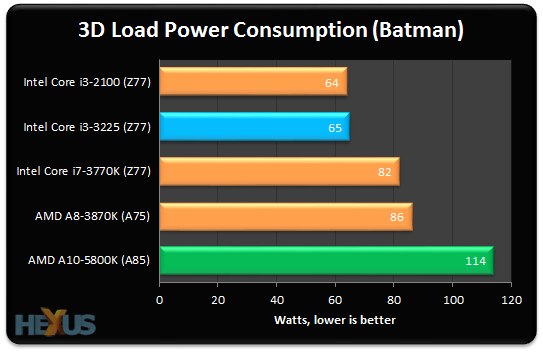GPGPU, plus power

AMD makes high-falutin' claims about its GPGPU pedigree, where applications run faster on the GPU. Our sole test, LuxMark, paints an unclear picture. Intel's HD Graphics put up a better-than-expected showing.
Power consumption
A well-thought-out recommendation for a processor also needs to take power-draw and energy efficiency into account. Overall performance can be improved by throwing more juice into the mix, at the direct expense of cooling and, perhaps, form factors.

Most PCs spend the majority of their time in an idle or near-idle state. The A10-5800K does well enough here. For what it's worth, the Mini-ITX board for the A8-3870K produces the best-in-class platform numbers.

Ah, here's a chink in the armour. The Intel Core i3-3225 ships with a 55W TDP - considered low for a mainstream desktop chip - while AMD's two APUs chime in at 100W. The A10-5800K, as a platform, chews through almost 2x the power-draw of the comparison Intel processor.
One reason for this elevated power-draw rests with the method by which AMD implements its Turbo Core overclocking. All cores jump to 4.2GHz when running CPU-intensive benchmarks, as you would expect, but behind-the-scenes voltage overclocking increasing the juice from 1.325V to a heady 1.475V. You don't need us to tell you this is bad for power consumption.

There's also a marked rise in power-draw when gaming on the IGP. We left the underlying Gigabyte F2-A85X-UP4's voltage selection to auto, per the methodology employed on other boards, though it may well be adding a shade more power than anticipated.
Thinking about the two under-load results, we'd feel far more comfortable with the A10-5800K's platform power consumption if it was on the right side of 100W.









